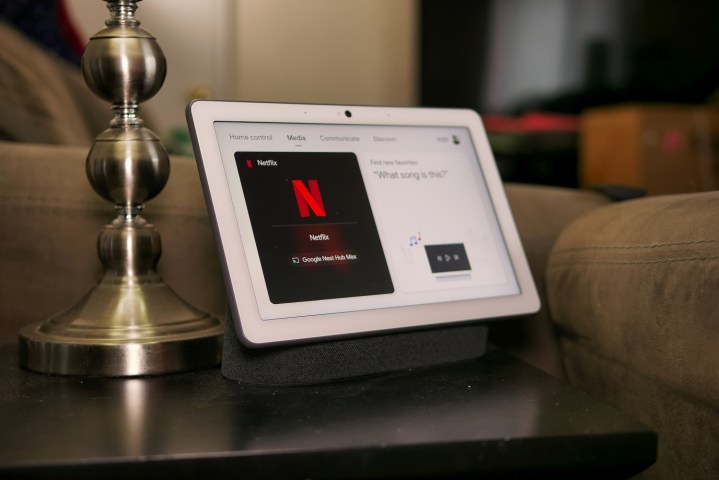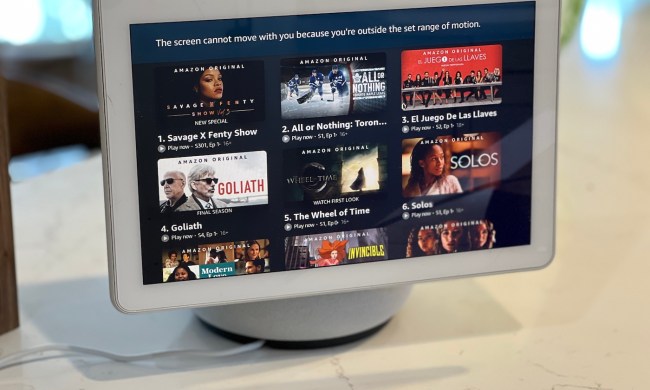Amazon’s Echo Show has competition from brands like Lenovo, Facebook, and others, but the Google Nest Hub Max is perhaps its biggest competitor.
The Echo Show and the Google Nest Hub Max are the two main options to consider right now if you’re looking at full-sized offerings, as opposed to the smaller, more compact options (think Nest Hub and Echo Show 5) since they offer greater media fidelity and smart home features. Side-by-side, there is no denying that they closely match each other in several key areas — screen size, sound quality, and price. But, there can only be one that comes out on top. We’ll evaluate both options — the Nest Hub Max and the Echo Show (3rd Gen) — to help you find out which smart display is right for you.
Sound

Music aficionados will certainly be pleased by the sound performance out of these two smart displays, delivering excellent sound quality paired with deep bass that can fill larger room spaces. They do well in open spaces, serving as centerpieces in areas like the kitchen or living room.
The Echo Show’s fantastic sound quality is due to its dual one-inch tweeters and 3-inch woofer. The speakers fill up the room with multidimensional sound, and most people won’t be disappointed by the bass. A neat trick up its sleeve is the ability to adjust the bass and treble by telling Alexa. The newest Echo Show also boasts the MediaTek 8183 as its main processor plus a second processor with Amazon AZ1 Neural Edge. Amazon plans to use the Az1 processor for better speech recognition in the future.
Meanwhile, the Nest Hub Max leverages dual 10W tweeters, accompanied by a 30W subwoofer. The package doesn’t disappoint as the bass roars to the beats, without overpowering the mids and highs. For those who prefer a more neutral audio performance, the bass and treble can be adjusted for a more personalized performance through the Google Home app. The only issue with the Nest Hub Max’s performance is that it can sound strained at higher volumes, but it still packs quite a punch at moderate volume levels.
Screen
When it comes to a video home hub, a great screen is one of the most important features. Both the Echo Show and the Nest Hub Max have big, crystal-clear screens. The Nest Hub Max comes with a 10-inch HD screen with 1280 x 800 resolution, while the Echo has a 10.1-inch HD screen with 1,280 x 800 resolution. So basically, the screen specs are just about the same.
Thanks to their larger screens, it makes media consumption a lot more tasteful. Take for example reading step-by-step instructions on a dish you’re preparing, or perhaps watching a YouTube clip on that particular dish — it’s a lot easier to do on these smart displays than on your smartphone.
Google Nest Hub Max’s screen has Ambient EQ technology that adjusts the screen’s look to make it look more life-like. We’re serious when we say that it’s the best looking digital photo frame around, nothing comes close to replicating its beautiful looks.
If you’re looking for something a bit smaller, especially for tight spaces, Amazon’s Echo Show 5 and Show 8 are better fits if you prefer Alexa’s calm voice. Alternatively, the Google Nest Hub complements its bigger sized sibling, but just know that it lacks a camera for proper two-way video chat.
Camera

The camera category is what sets these two hubs apart. The latest Echo Show (3rd Gen) has a 13MP camera plus a shutter, which isn’t bad. It’s better than the camera on the Nest Hub Max, but the Nest Hub Max’s camera has a few neat features too.
The Nest Hub Max includes a 6.5MP camera with a 127-degree field of view, auto-framing, and face-match technology. This means that the camera can identify you and bring up your personal calendar and other items on the screen when you approach. Also, when you are on a video call, it will follow you as you move around the room, keeping you in the shot. The newest Echo Show has gained the ability to automatically turn to face you when you’re on a call or watching content.
The Nest Hub Max camera can also be used as a Nest Cam security camera, as well. It has advanced features like familiar face alerts when paired with a Nest Aware subscription. Plus, with gesture control, holding your hand out to the camera will pause or play video when the camera recognizes you’re looking at it.
Smart home compatibility and connectivity
When it comes to compatibility with your other smart home devices, you’re going to be pleased with either option. Both hubs are compatible with Nest cameras, though remember that Nest Hub Max can become a Nest security camera. You can check to see if your devices are compatible with Echo here and compatible with Nest Hub Max here. Alexa is compatible with more devices, but Google Assistant still works with most moderns smart home products. The new Echo also lets you set up Zigbee compatible devices without a hub, and you can also access the Show’s camera while you’re away to monitor your home.
Video calls

It’s possible that the deciding factor for your choice of hubs could come down to who you want to call. Echo supports video calling capabilities to anyone with the Alexa app, Skype, an Echo Spot, or Echo Show, for example. The Nest Hub Max, on the other hand, connects video through Google Duo. The Duo feature is compatible with Android smartphones, iPhones, and Chrome browsers, specifically. Video calling preferences are totally subjective, we know, but we really like the auto-framing and zooming feature on the Nest Hub Max. That tool helps keep us centered, focused, and in-frame, no matter how far away we are from the camera itself. Consequently, you have the freedom to be more mobile while you talk because you no longer have to focus on whether or not you’re in the frame.
Price
Fortunately, the price for both items comes to be about neck-and-neck. The Google Nest Hub Max was launched at a retail price of $229. We anticipate that the Amazon Echo Show will release later this year at a retail price of around $250. That said, when the holiday season rolls around, you can expect more discounts for the Amazon Echo Show and potentially a few bundle deals to sweeten the pot even more. You’ll also spot discounts on older, refurbished, or smaller Echo models (like the Echo Show 8 or Echo Show 5). You may not be able to find deals as readily available for the Google Nest Hub Max.
Conclusion
When you compare the two devices, the Echo Show and the Nest Hub Max are both extremely similar and effective smart home video hubs. They’re ranked at similar price points, provide fantastic video and audio quality, come with virtual assistants, and can effectively link up with other smart gadgets in your home. That said, the new Echo Show tips the scales thanks mainly to its 13MP camera. The Google Nest Hub Max is also a great option, though, doubling as a good security camera. Furthermore, Nest Hub Maxes uses Ambient IQ technology, making it the best choice for the most professionally aesthetic-looking digital photo frames.


